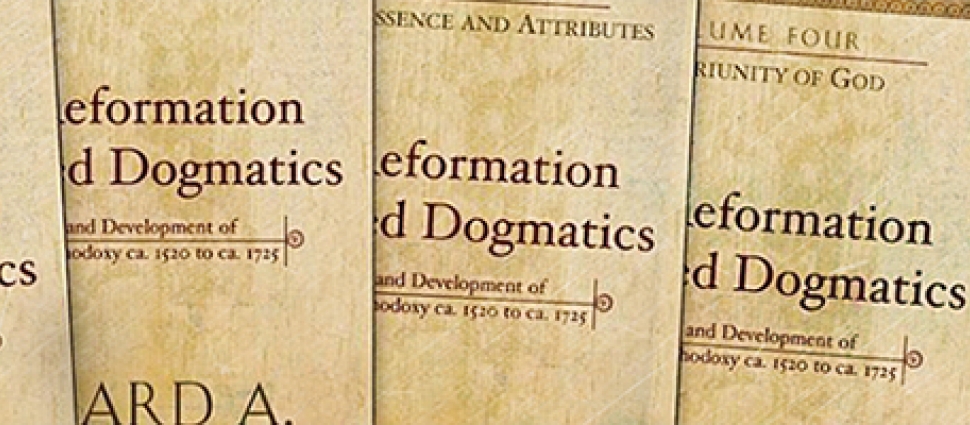A Year in PRRD (Week 2)

 Every Wednesday in 2018, Michael Lynch (PhD candidate at Calvin Theological Seminary) and our own editor Danny Hyde (PhD candidate at Vrije Universiteit Amsterdam) will be blogging through Richard Muller’s Post-Reformation Reformed Dogmatics, 4 vols. (2nd edition, Grand Rapids: Baker Academic, 2003).
Every Wednesday in 2018, Michael Lynch (PhD candidate at Calvin Theological Seminary) and our own editor Danny Hyde (PhD candidate at Vrije Universiteit Amsterdam) will be blogging through Richard Muller’s Post-Reformation Reformed Dogmatics, 4 vols. (2nd edition, Grand Rapids: Baker Academic, 2003).
These volumes are currently out-of-print but used copies can be found online here. For a schedule of weekly readings, go here.
Week 2 (1/8-1/14): I.1.1.2–3 (pgs. 46–84)
When I saw that my friend Michael Lynch was going to Tweet/blog through Muller’s PRRD, it was a spur for me to re-read my way through. Then we decided to join forces. But since he’s a real scholar and not a pastor-“scholar” like me, I told him my comments would be John Madden-esque as I read through a section: “Boom! Whack!!”
Seriously, the work of Muller and those who have dedicated the lifespan of their brain cells to reassessing the Reformation and Post-Reformation played a part in assuring my soul. As strange as that might sound, it’s true. I was a rootless 19-year old—I came from a broken family, I was saved a little more than a year before, went to play basketball at a Christian college because I thought that would be better for my spiritual life, only to find myself disillusioned by all the PKs and MKs who couldn't care less. A part of my journey to stability emotionally and theologically was finding on a used bookshelf in a Christian bookstore a copy of the 1988 edition of Muller’s, Christ and the Decree. I still have it! I hardly had any idea what he was saying, but I knew it was the kind of serious history into the Christian past I had to get more of if I was going to figure out what I believed and where I was going in life.
Here in PRRD I.1.1.2–3 we have a mini-history of Reformation through Post-Reformation theology. It’s not easy to give to a parishioner, but as a pastor, it’s the kind of summary I need to be familiar with so that I can distill it to my peeps.
I.1.1.2 contrasts the false narrative that the Reformation was alive, vibrant, and a period when the “living Word” had its way only to be quenched by “dead orthodoxy” in the Post-Reformation period. As Muller explains, the relationship to these two periods is doctrinal continuity through the means of methodological discontinuity (46). One way Muller accounts for this phenomenon is what he calls “the underlying drive of the Reformation…the drive toward true or correct doctrine” (47). In other words, of course theology is going to feel like it’s changed because the needs changed: from Luther-esque proclamation to catechetical instruction of newly Reformed people, to polemical precision between Catholics and Protestants (and Protestants and Protestants), then finally to establishing university faculty norms. Even Calvin’s own Institutes, so falsely seen by some as the Rosetta Stone of pure biblical proclamation, underwent significance changes in form and structure as the needs changed over the course of his life (56–58). So what is Reformed “orthodoxy?” Muller summarizes: “a conscious attempt to reflect in detail the early confessional synthesis of Reformed doctrine” (59).
The main thing I want you to take away from the heavy-going section I.1.1.3 is a practical point so necessary in today’s ecclesiastical climate. I write as a minister in the URCNA so my exhortation is to those of us in the über-conservative, ultra-confessional world of Reformedom. Muller says, “High orthodoxy…modified, developed, and elaborated extant system in relation to a changing intellectual environment” (74). Again, in relation to ad intra controversies and polemics within the Reformed churches surrounding Cocceian covenant theology, appropriating Cartesian philosophy, aspects of Saumur theology, Baxter’s soteriology, and how to respond to Socinianism’s denial of God’s ad intra attribute of punitive justice, Muller says, “On none of these issues, however, did the Reformed churches rupture into separate confessional bodies or identify a particular theologically defined group as beyond the bounds of the confessions, as had been the case at the Synod of Dort” (76). Too many of us today use the confessions as a rod and not as a staff. We view them as walls, not boundary markers. We’re more concerned with repristinating a “pure age” of theology, piety, and practice, which ironically is exactly what the “Calvin v. Calvinists” school of thought has tried to do with Reformed theology.
Join us next Wednesday as Michael Lynch blogs through the reading for Week 3 (1/15-1/21): I.1.2 (pgs. 85–146)!
Meet the Puritans is a conversation of the Alliance of Confessing Evangelicals. It is supported only by its readers and gracious Christians like you. Please prayerfully consider supporting us.
For previous posts in this series, see:





